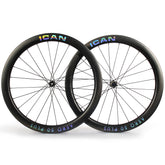A comprehensive guide to gravel cycling and 2024 bikes
What is gravel cycling?
Gravel cycling is a mix of road cycling and mountain biking. These rides vary between paved roads and rough terrain. Gravel bikes are designed to handle any challenge, with unique frame geometry and components adapted to unpredictable conditions.
At first glance, a gravel bike resembles a racing bike due to the curved handlebars. However, upon closer inspection, it has its own characteristics, especially in the frame construction. The wheels on a gravel bike also have wider rims than those on a racing bike or mountain bike.
Gravel bikes are specifically designed for rough, unpaved and unpredictable terrain. They have wider rims that can accommodate wider tires than most road bike rims. This ensures better stability, control and comfort on gravel roads, even up to 60mm!
Can I use my regular road bike wheels for gravel?
Yes, you can use road wheels on a gravel bike to ride on unpaved terrain. However, dedicated gravel bikes offer better stability, control, traction and comfort on such terrain.
The advantages of gravel bikes
1. Improved stability and control
One of the main benefits of dedicated gravel wheels is the improved stability and control they provide. Gravel roads can be unpredictable and bumpy, making it difficult to maintain balance and control. However, wheels specifically designed for this type of terrain have wider rims that can be fitted with wider tires and provide a larger contact area on the ground. This results in greater stability and control, allowing the rider to have a smoother ride over gravel and other unpaved roads.
2. Increased traction
Another advantage of special wheels for gravel use is improved traction. Gravel roads can be slippery and unpredictable, and the right wheels can make a significant difference in the grip of the road. By installing wider tires on gravel bikes, you get more surface area, which results in better traction, even on loose gravel.
3. More comfortable driving
Gravel roads can be rough and unpleasant, but special wheels designed for this type of terrain make the ride more comfortable. The wider rims with wider tires absorb shocks and vibrations, reducing the impact on the rider's body. This results in a smoother ride so you can enjoy your adventure without feeling every bump and bump.
4. Better durability
Gravel roads can put a lot of strain on wheels and wear them out over time. However, dedicated gravel road wheels are designed to withstand the harsh terrain and are more durable than regular road bike wheels. This means you can ride longer and harder without worrying about damaging your wheels.
Tubeless gravel tire vs. tubeless clincher tire
Tubeless is king on gravel because tubeless tires have no tubes and are therefore more resistant to the sharp, flint-like gravel found at events like Unbound. That means:
Tubeless tires can be run at lower pressures than clincher tires, resulting in a smoother ride.
Tubeless gravel tires can help prevent flat tires, also known as snake bites. They occur when a tire hits a rock or bump, causing it to press against the rim and form a crack. This crack eventually causes the tire to deflate quickly.
Gravel tires that do not have tubes must be used with a sealant. Should something penetrate the tire, the sealant fluid will quickly fill and seal the hole. A plug kit can be used to repair flat tires while driving. By inserting the plug into the hole and using CO2 or a pump to operate the valve, you'll be up and running again in no time.
Gravel Bike Size Guide
The size of gravel bikes is similar to that of road bikes, with most brands using the length of the seat tube in centimeters for the frame size. However, some brands use T-shirt-like sizing. In general, your posture on a gravel bike will be more relaxed and upright than on a road bike. This is because you have to shift your weight more on terrain to maintain balance and steer your bike over obstacles. An upright position is more comfortable even on uneven terrain. However, if you're interested in gravel racing, a longer and lower position will reduce your frontal profile and potentially make you faster.
|
Rider height |
|
Frame size |
|
|
Feet and inches |
Centimetres |
Effective top tube (cm) |
Bike size |
|
4ft 10in – 5ft |
148-152 |
47-48 |
XXS |
|
5ft – 5ft 3in |
152-160 |
49-50 |
XS |
|
5ft 3in – 5ft 6in |
160-168 |
51- 3 |
S |
|
5ft 6in – 5ft 9in |
168-175 |
54-55 |
M |
|
5ft 9in – 6ft |
175-183 |
56-58 |
L |
|
6ft – 6ft 3in |
183-191 |
58-60 |
XL |
|
6ft 3in – 6ft 6in |
191-198 |
61-63 |
XXL |
What makes a gravel bike?
Gravel bikes are versatile all-terrain bikes that are particularly well suited to mixed terrain and offer a unique blend of speed, maneuverability and stability. They are compatible with gravel tires, which are wider than typical road bike tires but narrower than standard mountain bike tires.
The best gravel bike wheels are lightweight, stiff and durable and are designed to withstand the challenging and unpredictable conditions of riding on mixed terrain in any weather. These wheels offer exceptional performance and stability, allowing the rider to tackle technical off-road descents and narrow singletrack while maintaining impressive speed on paved surfaces.
One of the key features that sets gravel bikes apart from other bikes such as hardtail mountain bikes and cyclocross bikes is the variety of mounts that make it easy to transport luggage and attach stylish accessories. This feature makes them ideal for touring and bike packing adventures.








